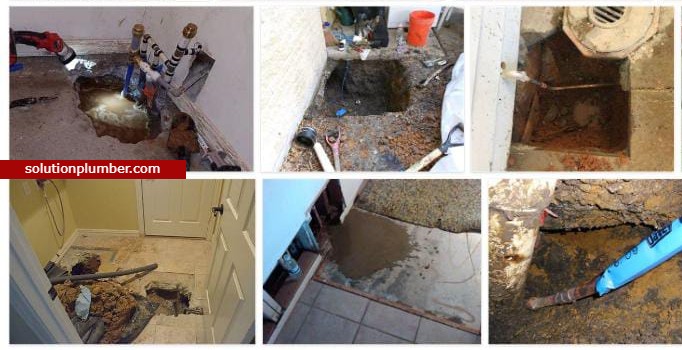Is there a region on your floor that is particularly warm? Is the ground around your house particularly wet? If you have a slab foundation, any of these could be signs of slab leak symptoms.

Many people believe that repairing a leaking pipe beneath a slab will be difficult. However, not as difficult as you may believe. It can be difficult to find and obtain access to the pipe, but once you know where the leak is coming from and can cut your way through the slab, repairing the line is simple.
HOW TO DETERMINE IF THERE IS A LEAK UNDER A SLAB
There are several signs that indicate you have a leak under a slab. Check the option below How to Tell if You Have a Leak Under a Slab.
Pipes
Pay attention to the signs of the situation coming from the pipe;
Water or moist spots on your floor are the first signs. Warm spots on your floor may be caused by leaking hot-water lines. Because you can feel the heat through the floor when walking around with bare feet within your home, you can pinpoint the location of any leaking lines.
The sound of rushing water beneath your floor can also be an indication that your water lines are leaking. You most likely have a leak in your piping if it appears as if a faucet is turned on beneath your house.
A sudden rise in your water bill could indicate a leaking pipe. Your water bill will increase as a broken line continues to run. If you see an increase that you can't explain, you either have a leak or your water company is taking advantage of you.
Sewage System
A different problem is leaking sewer lines. They are more difficult to identify, and can go unnoticed until noticeable indicators appear, such as foundation deterioration or domed (raised) flooring areas. Check your foundation for "heaving," which happens when the slab swells enough to elevate the entire structure, if you suspect a leaky sewer line.
Elusive Leaks
Some leaks are difficult to locate and necessitate the use of specialist listening devices (sonar), infrared cameras, or helium detectors. Air is pushed into the lines after turning off the water altogether. Any residual water is forced out, allowing the plumber to listen for air escaping from the damaged pipe.
Foundation Heaving
If your foundation slab swells to an extreme degree, it can cause the building to rise slightly. Heaving is the term for this event. If your property has heaved due to a leak beneath the slab foundation, it is vital that you get professional help in repairing it.
A rapid, considerable movement in the foundation of a building can cause serious, often irreversible damage to the structure. Cracks might appear on the inner and exterior walls, as well as the slab itself, as a result of this damage. Because settling in the building's foundation can also create these indicators of damage, it's crucial to seek the advice of a skilled repair professional who can distinguish between the two.
SLAB LEAK DETECTION EQUIPMENT
If you can't find a leak using the previous methods, it could be worth investing in specialized leak detection equipment. To find leaks, professional plumbers frequently drain the water from a building's water lines and then pump in air. To pinpoint the exact location of a leak, the plumber will normally use specific sound equipment.
The average cost of identifying a slab leak is between $150 and $400 in most circumstances. While it is advised that you hire an experienced plumber, you can purchase the necessary tools to discover the leak on your own.
HOW TO FIX A SLAB LEAK
Once the leak has been located, a plumber can assess the issue and the leak's location. At this step, a strategy is devised and implemented. In certain circumstances, it's preferable to re-plumb the afflicted area, while in others, new plumbing throughout the house is required. Attempting to fix old, galvanized plumbing is usually a waste of money, as aging pipes will continue to leak.
Gaining Access
To get to the pipe after finding the leak, you'll need to jackhammer a hole in the floor. In order to reveal the concrete, the finished flooring will be removed. Because opening a slab generates a lot of dust, it's crucial to cover or remove any furniture or valuables. The dirt is removed from the hole once it has been cut, allowing access to the leaking pipe.
Repairing Damaged Water Lines
Copper pipes are the most commonly utilized for water lines beneath slab foundations. Copper pipes, unfortunately, are prone to wearing out and springing leaks as they get older. Consider re-piping rather than utilizing a temporary fix before initiating repairs on a portion of pipe beneath a concrete slab.
If you choose to repair rather than replace the copper pipe, the process is rather simple. Cut out the damaged section with a hacksaw or a tubing cutter. To correct the flow, just replace it with new tubing and copper couplings before soldering it in place. The pipe will be buried, the concrete will be restored, and the floors will be repaired.
Repairing Sewer Lines
While a leaking water pipe can usually be repaired by the homeowner, a leaking sewer line may need the help of a plumber. Consider the sort of pipes that were utilized, as well as the health risks associated with exposure to human waste, before deciding to take on this type of project yourself.
Sewer lines might be cast iron, clay, or even PVC, depending on the age of the house. Rubber couplings are excellent for joining various types of pipes, but they should not be used beneath concrete slabs. Rubber boots degrade with time, especially if they are used outside. Working directly with a plumber will enable you to gain a better understanding of the situation and provide you with the finest options for your home.